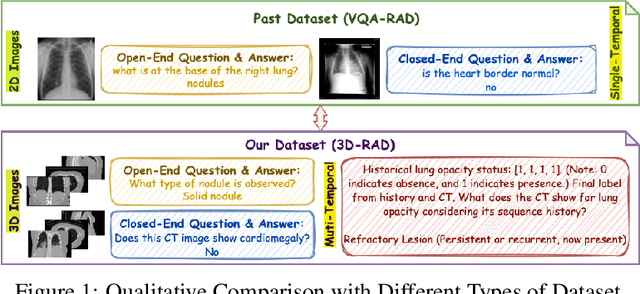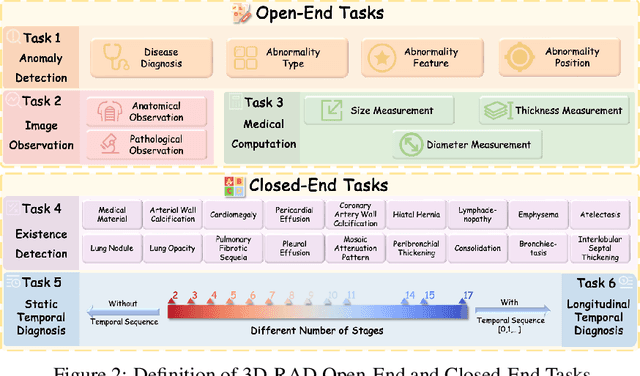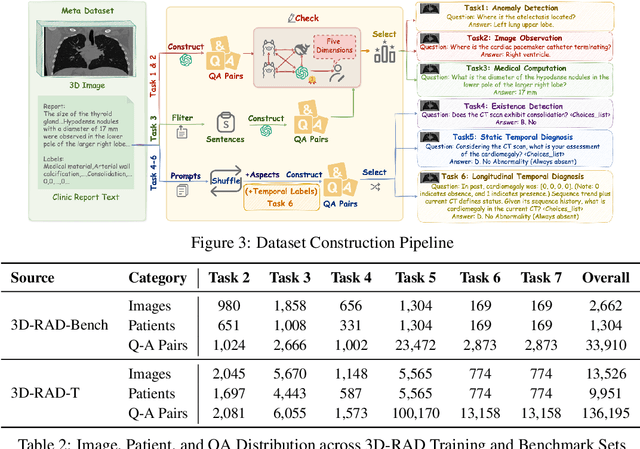Zuozhu Liu
Modest-Align: Data-Efficient Alignment for Vision-Language Models
Oct 24, 2025Abstract:Cross-modal alignment aims to map heterogeneous modalities into a shared latent space, as exemplified by models like CLIP, which benefit from large-scale image-text pretraining for strong recognition capabilities. However, when operating in resource-constrained settings with limited or low-quality data, these models often suffer from overconfidence and degraded performance due to the prevalence of ambiguous or weakly correlated image-text pairs. Current contrastive learning approaches, which rely on single positive pairs, further exacerbate this issue by reinforcing overconfidence on uncertain samples. To address these challenges, we propose Modest-Align, a lightweight alignment framework designed for robustness and efficiency. Our approach leverages two complementary strategies -- Random Perturbation, which introduces controlled noise to simulate uncertainty, and Embedding Smoothing, which calibrates similarity distributions in the embedding space. These mechanisms collectively reduce overconfidence and improve performance on noisy or weakly aligned samples. Extensive experiments across multiple benchmark datasets demonstrate that Modest-Align outperforms state-of-the-art methods in retrieval tasks, achieving competitive results with over 100x less training data and 600x less GPU time than CLIP. Our method offers a practical and scalable solution for cross-modal alignment in real-world, low-resource scenarios.
Knowing or Guessing? Robust Medical Visual Question Answering via Joint Consistency and Contrastive Learning
Aug 26, 2025Abstract:In high-stakes medical applications, consistent answering across diverse question phrasings is essential for reliable diagnosis. However, we reveal that current Medical Vision-Language Models (Med-VLMs) exhibit concerning fragility in Medical Visual Question Answering, as their answers fluctuate significantly when faced with semantically equivalent rephrasings of medical questions. We attribute this to two limitations: (1) insufficient alignment of medical concepts, leading to divergent reasoning patterns, and (2) hidden biases in training data that prioritize syntactic shortcuts over semantic understanding. To address these challenges, we construct RoMed, a dataset built upon original VQA datasets containing 144k questions with variations spanning word-level, sentence-level, and semantic-level perturbations. When evaluating state-of-the-art (SOTA) models like LLaVA-Med on RoMed, we observe alarming performance drops (e.g., a 40\% decline in Recall) compared to original VQA benchmarks, exposing critical robustness gaps. To bridge this gap, we propose Consistency and Contrastive Learning (CCL), which integrates two key components: (1) knowledge-anchored consistency learning, aligning Med-VLMs with medical knowledge rather than shallow feature patterns, and (2) bias-aware contrastive learning, mitigating data-specific priors through discriminative representation refinement. CCL achieves SOTA performance on three popular VQA benchmarks and notably improves answer consistency by 50\% on the challenging RoMed test set, demonstrating significantly enhanced robustness. Code will be released.
Datasets and Recipes for Video Temporal Grounding via Reinforcement Learning
Jul 24, 2025Abstract:Video Temporal Grounding (VTG) aims to localize relevant temporal segments in videos given natural language queries. Despite recent progress with large vision-language models (LVLMs) and instruction-tuning, existing approaches often suffer from limited temporal awareness and poor generalization. In this work, we introduce a two-stage training framework that integrates supervised fine-tuning with reinforcement learning (RL) to improve both the accuracy and robustness of VTG models. Our approach first leverages high-quality curated cold start data for SFT initialization, followed by difficulty-controlled RL to further enhance temporal localization and reasoning abilities. Comprehensive experiments on multiple VTG benchmarks demonstrate that our method consistently outperforms existing models, particularly in challenging and open-domain scenarios. We conduct an in-depth analysis of training strategies and dataset curation, highlighting the importance of both high-quality cold start data and difficulty-controlled RL. To facilitate further research and industrial adoption, we release all intermediate datasets, models, and code to the community.
CAPO: Reinforcing Consistent Reasoning in Medical Decision-Making
Jun 15, 2025



Abstract:In medical visual question answering (Med-VQA), achieving accurate responses relies on three critical steps: precise perception of medical imaging data, logical reasoning grounded in visual input and textual questions, and coherent answer derivation from the reasoning process. Recent advances in general vision-language models (VLMs) show that large-scale reinforcement learning (RL) could significantly enhance both reasoning capabilities and overall model performance. However, their application in medical domains is hindered by two fundamental challenges: 1) misalignment between perceptual understanding and reasoning stages, and 2) inconsistency between reasoning pathways and answer generation, both compounded by the scarcity of high-quality medical datasets for effective large-scale RL. In this paper, we first introduce Med-Zero-17K, a curated dataset for pure RL-based training, encompassing over 30 medical image modalities and 24 clinical tasks. Moreover, we propose a novel large-scale RL framework for Med-VLMs, Consistency-Aware Preference Optimization (CAPO), which integrates rewards to ensure fidelity between perception and reasoning, consistency in reasoning-to-answer derivation, and rule-based accuracy for final responses. Extensive experiments on both in-domain and out-of-domain scenarios demonstrate the superiority of our method over strong VLM baselines, showcasing strong generalization capability to 3D Med-VQA benchmarks and R1-like training paradigms.
Med-U1: Incentivizing Unified Medical Reasoning in LLMs via Large-scale Reinforcement Learning
Jun 14, 2025



Abstract:Medical Question-Answering (QA) encompasses a broad spectrum of tasks, including multiple choice questions (MCQ), open-ended text generation, and complex computational reasoning. Despite this variety, a unified framework for delivering high-quality medical QA has yet to emerge. Although recent progress in reasoning-augmented large language models (LLMs) has shown promise, their ability to achieve comprehensive medical understanding is still largely unexplored. In this paper, we present Med-U1, a unified framework for robust reasoning across medical QA tasks with diverse output formats, ranging from MCQs to complex generation and computation tasks. Med-U1 employs pure large-scale reinforcement learning with mixed rule-based binary reward functions, incorporating a length penalty to manage output verbosity. With multi-objective reward optimization, Med-U1 directs LLMs to produce concise and verifiable reasoning chains. Empirical results reveal that Med-U1 significantly improves performance across multiple challenging Med-QA benchmarks, surpassing even larger specialized and proprietary models. Furthermore, Med-U1 demonstrates robust generalization to out-of-distribution (OOD) tasks. Extensive analysis presents insights into training strategies, reasoning chain length control, and reward design for medical LLMs. The code will be released.
Mitigating Posterior Salience Attenuation in Long-Context LLMs with Positional Contrastive Decoding
Jun 11, 2025Abstract:While Large Language Models (LLMs) support long contexts, they struggle with performance degradation within the context window. Current solutions incur prohibitive training costs, leaving statistical behaviors and cost-effective approaches underexplored. From the decoding perspective, we identify the Posterior Salience Attenuation (PSA) phenomenon, where the salience ratio correlates with long-text performance degradation. Notably, despite the attenuation, gold tokens still occupy high-ranking positions in the decoding space. Motivated by it, we propose the training-free Positional Contrastive Decoding (PCD) that contrasts the logits derived from long-aware attention with those from designed local-aware attention, enabling the model to focus on the gains introduced by large-scale short-to-long training. Through the analysis of long-term decay simulation, we demonstrate that PCD effectively alleviates attention score degradation. Experimental results show that PCD achieves state-of-the-art performance on long-context benchmarks.
3D-RAD: A Comprehensive 3D Radiology Med-VQA Dataset with Multi-Temporal Analysis and Diverse Diagnostic Tasks
Jun 11, 2025



Abstract:Medical Visual Question Answering (Med-VQA) holds significant potential for clinical decision support, yet existing efforts primarily focus on 2D imaging with limited task diversity. This paper presents 3D-RAD, a large-scale dataset designed to advance 3D Med-VQA using radiology CT scans. The 3D-RAD dataset encompasses six diverse VQA tasks: anomaly detection, image observation, medical computation, existence detection, static temporal diagnosis, and longitudinal temporal diagnosis. It supports both open- and closed-ended questions while introducing complex reasoning challenges, including computational tasks and multi-stage temporal analysis, to enable comprehensive benchmarking. Extensive evaluations demonstrate that existing vision-language models (VLMs), especially medical VLMs exhibit limited generalization, particularly in multi-temporal tasks, underscoring the challenges of real-world 3D diagnostic reasoning. To drive future advancements, we release a high-quality training set 3D-RAD-T of 136,195 expert-aligned samples, showing that fine-tuning on this dataset could significantly enhance model performance. Our dataset and code, aiming to catalyze multimodal medical AI research and establish a robust foundation for 3D medical visual understanding, are publicly available at https://github.com/Tang-xiaoxiao/M3D-RAD.
SurgBench: A Unified Large-Scale Benchmark for Surgical Video Analysis
Jun 09, 2025Abstract:Surgical video understanding is pivotal for enabling automated intraoperative decision-making, skill assessment, and postoperative quality improvement. However, progress in developing surgical video foundation models (FMs) remains hindered by the scarcity of large-scale, diverse datasets for pretraining and systematic evaluation. In this paper, we introduce \textbf{SurgBench}, a unified surgical video benchmarking framework comprising a pretraining dataset, \textbf{SurgBench-P}, and an evaluation benchmark, \textbf{SurgBench-E}. SurgBench offers extensive coverage of diverse surgical scenarios, with SurgBench-P encompassing 53 million frames across 22 surgical procedures and 11 specialties, and SurgBench-E providing robust evaluation across six categories (phase classification, camera motion, tool recognition, disease diagnosis, action classification, and organ detection) spanning 72 fine-grained tasks. Extensive experiments reveal that existing video FMs struggle to generalize across varied surgical video analysis tasks, whereas pretraining on SurgBench-P yields substantial performance improvements and superior cross-domain generalization to unseen procedures and modalities. Our dataset and code are available upon request.
Act-as-Pet: Benchmarking the Abilities of Large Language Models as E-Pets in Social Network Services
Jun 04, 2025Abstract:As interest in using Large Language Models (LLMs) for interactive and emotionally rich experiences grows, virtual pet companionship emerges as a novel yet underexplored application. Existing approaches focus on basic pet role-playing interactions without systematically benchmarking LLMs for comprehensive companionship. In this paper, we introduce Pet-Bench, a dedicated benchmark that evaluates LLMs across both self-interaction and human-interaction dimensions. Unlike prior work, Pet-Bench emphasizes self-evolution and developmental behaviors alongside interactive engagement, offering a more realistic reflection of pet companionship. It features diverse tasks such as intelligent scheduling, memory-based dialogues, and psychological conversations, with over 7,500 interaction instances designed to simulate complex pet behaviors. Evaluation of 28 LLMs reveals significant performance variations linked to model size and inherent capabilities, underscoring the need for specialized optimization in this domain. Pet-Bench serves as a foundational resource for benchmarking pet-related LLM abilities and advancing emotionally immersive human-pet interactions.
CP-Router: An Uncertainty-Aware Router Between LLM and LRM
May 26, 2025Abstract:Recent advances in Large Reasoning Models (LRMs) have significantly improved long-chain reasoning capabilities over Large Language Models (LLMs). However, LRMs often produce unnecessarily lengthy outputs even for simple queries, leading to inefficiencies or even accuracy degradation compared to LLMs. To overcome this, we propose CP-Router, a training-free and model-agnostic routing framework that dynamically selects between an LLM and an LRM, demonstrated with multiple-choice question answering (MCQA) prompts. The routing decision is guided by the prediction uncertainty estimates derived via Conformal Prediction (CP), which provides rigorous coverage guarantees. To further refine the uncertainty differentiation across inputs, we introduce Full and Binary Entropy (FBE), a novel entropy-based criterion that adaptively selects the appropriate CP threshold. Experiments across diverse MCQA benchmarks, including mathematics, logical reasoning, and Chinese chemistry, demonstrate that CP-Router efficiently reduces token usage while maintaining or even improving accuracy compared to using LRM alone. We also extend CP-Router to diverse model pairings and open-ended QA, where it continues to demonstrate strong performance, validating its generality and robustness.
 Add to Chrome
Add to Chrome Add to Firefox
Add to Firefox Add to Edge
Add to Edge